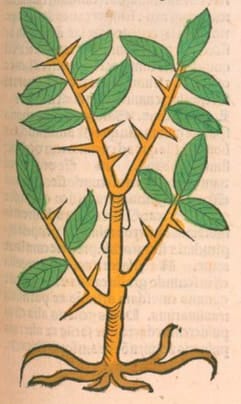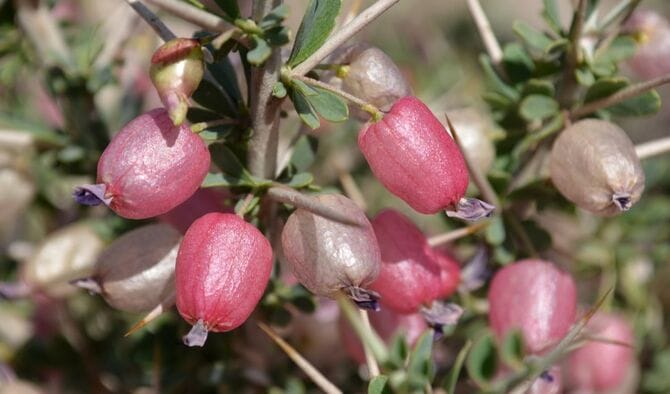Sarcocolla
Azerat (Unani)Anzarut, Anzurut (Arabic, Persian)
Gujar (Ayurveda)
 Ortus Sanitatis, Meydenbach, 1491
Ortus Sanitatis, Meydenbach, 1491 Astragalus sarcocolla
Astragalus sarcocolla(Photo by auoob farabi) (Wikimedia)
Botanical name:
Astragalus sarcocolla, A. fasciculufolius
Parts used:
Gum
“The best variety is that which is yellowish and resembles Luban (Olibanum)”. (Avicenna)
Temperature & Taste:
Warm, dry. Pungent, Bitter, Sweet
“Some physicians say that Sarcocolla is Hot in the Second and Dry in the First degree” (Avicenna), although others said it was hot.
Classifications:
2X. INCARNATIVE. 2Z. CICATRIZING
Preparers and Purgers of Phlegm
Laxative, Purgatives and Cathartics
Uses:
1. Clears Cold-Phlegm, Stops Cough:
-Cough, Asthma from Cold Phlegm
-clears Phlegm and digests Humors; prepares Phlegm Humor for purging
-Cold Phlegm of the Stomach, for which purpose it was used to help clear Obesity
–Mesue and other Arab physicians regarded it as a Phlegm purgative for Crass and Crude Phlegm
2. Settles Wind, Clears Damp and Phlegm:
-Epilepsy, Paralysis, Dizziness, Vertigo and other Wind-Phlegm / Wind-Damp diseases of the Brain and Nerves
-Wind-Phlegm swellings including Scrofula
–can ‘put people in a happy mood’ (Galen)
3. Clears Wind-Damp, Eases Pain:
-Wind-Damp Rheumatic and Arthritic complaints
-Sciatica, Lower back pain
-“expels thick and unripe phlegm, especially from the hips and joints”. (Avicenna)
4. Kills Worms:
-in compounds for Worms, especially for Children
5. Externally:
-topically to close and heal wounds; it “deterges, heals, and cicatrizes”. (Avicenna)
-applied to Opthalmia and purulent discharge of the Eyes (classically with Milk)
-Earache, Otorrhea (roasted with onions and the juice applied) (Unani)
-“Its plaster gives relief in swellings”. (Avicenna)
-Fractures, Diclocations
Dose:
According to some practitioners it work best taken with Trikatu (Ginger, Long Pepper and Black Pepper)
60–1200mg (5–20 grains)
Substitute:
1. Galen said Sarcocolla has similar properties to Tragacanth, but is weaker.
Main Combinations:
1. Cold Phlegm of the Lungs:
i. Sarcocolla with Orris
ii. Sarcocolla with Agaric, Turbith, Orris root, Mastic, (as in Pills of Agaric of Mesue)
iii. Sarcocolla with Aloe, Agaric, Mastic, Stoechas, Hyssop (as in Pills of Isaac Heben)
2. Cold-Phlegm Asthma, Sarcocolla with Agaric, Turbith, Valerian, Licorice and Hyssop (Unani)
3. Wind-Phlegm diseases, Sarcocolla with Gum Ammoniac, Sagapen, Opopanax, Mastic, Cumin Asafetida, Orris (as in Electuary of Gums of Zenon)
4. To Purge Cold Phlegm:
i. Sarcocolla with Agaric, Turbith, Rock Salt, Ginger, Mastic, Aniseed, Aloe
ii. Sarcocolla with Agaric, Turbith, Mastic, Orris, Myrrh (as in Pills of Agaric)
iii. Sarcocolla (3 drams), Turbith (half oz.), Colocynth, Ginger (1 ½ drams each), Rock Salt (1 dram), form pills (Pills of Sarcocolla)
5. Hernia:
i. Sarcocolla with Comfrey, Pomegranate peel, Myrrh, Mastic (as in Electuary of Comfrey)
ii. Sarcocolla with Frankincense, Mastic, Myrrh, Red Earth, Shilajit, Tragacanth (as in Powder for Hernia of Vigo)
6. Arthritis, Rheumatism:
i. Sarcocolla with Colchicum, Aloe, Yellow Myrobalan, Turbith, Bdellium, Opopanax, Rue seed, Celery seed (as in Pills of Colchicum Major of Mesue)
7. Scrofula, Sarcocolla with Turpeth, Agaric, Sal Ammoniac, Colocynth, Hiera Picra (as in Pills for Scrofula of Unani)
8. Uterine Ulcers, Sarcocolla with Bdelium, Myrrh, Frankincense, Chebulic Myrobalan, Amber (as in Pills for Uterine Ulcers)
9. Eye Inflammation, Purulent Opthalmia:
i. beat Sarcocolla with Asses milk, then dried in an oven and applied (Avicenna)
ii. Sarcocolla macerated in Milk (1 dram), prepared Tutty (Zinc oxide) (½ dram), Mucilage of Quince seed extracted with Rose water (3 drams). Mix to make a collyrium. (A Treatise on Foreign Drugs, Geoffroy and Thicknesse, 1749)
10. Earache, Otorrhea, roast Sarcocolla in an Onion and drop the juice in the ear
11. For Head Wounds, Sarcocolla with Myrrh, Madder, Cyperus, Orris (as in Powder for Head Wounds of Andernacus)
12. Skull fractures, Sarcocolla with Dragons Blood, Myrrh
13. Fractures, Dislocations, Sarcocolla with Aloe, Alum, Frankincense, Turmeric, mixed into Spirit and applied.
14. Incarnating Powder (to cause flesh to grow in Wounds and Ulcers)
i. Sarcocolla with Aloe, Myrrh, mixed with White Wine and Honey (Luminare Majus)
ii. Sarcocolla with Aloe, Myrrh, Frankincense, Dragons Blood (equal parts)
15. Ulcers of the Genitals, Sarcocolla with Tutty (zinc oxide), Mastic, Dragons Blood, applied topically with Wax and Turpentine (Wirtzung)
16. A salve for Ulcerated Cancer of the Uterus, Sarcocolla with Aloe, Dragons Blood, Myrrh, Frankincense, mixed with Duck fat (Wirtzung)
17. Headache, Sarcocolla mixed with Sandalwood and Rose water and applied topically.
18. Pus discharging from the ears, form a wick with Sarcocolla and Honey, heals in a few days’ (Avicenna)
Major Formulas:
Electuary of Gums (Zenon)
Pills of Agaric (Avicenna)
Pills of Agaric (Mesue)
Pills of Colchicum Major (Mesue)
Pills of Isaac Heben
Hospital Pill to cleanse the Chest (Unani)
Cautions:
1. Avoid overdose
2. Avoid in Yin deficiency and dry Cough
3. ‘Constant use of Sarcocolla causes baldness especially among the old’. (Avicenna)
Main Preparations used:
-
Extra Info
-
History
|
‘This drug, though still largely used in the East, is hardly known in Europe at the present time. Dioscorides informs us that Sarcocolla is the tear of a Persian tree, that it resembles powdered Frankincense, is of a reddish colour and bitterish taste, has the property of closing wounds and checking discharges from the eyes. It is an ingredient in plasters, and is adulterated with gum. Pliny writes to the same effect, and adds that it is valued by painters, Ibn Sina says that it closes wounds without causing irritation and promotes granulation; used as plaster it mitigates all kinds of inflammation. Masih adds that it is cathartic and useful for the expulsion of phlegm and corrupt humours. Amongst modern writers, Mir Muhammad Husain, the author of the Makhzan-el-Adwiya, informs us that Anzerdt is at Ispahan called Kunjud and Agardhak, at Shiraz Kunderu; in Arabic it is known as Kohl-Farsi (Persian collyrium) and Kohl-Kirmani (Kirman collyrium). The Indians call it Lai. He describes it as the gum of a thorny plant called Shayakah, which is about 6 feet high, has leaves like those of the Frankincense, and is a native of Persia and Turkistan; he then gives a correct description of the drug, and states that it is aperient, and a resolvent of corrupt and phlegmatic humours, &c.; it acts best when combined with such medicines as turpeth, |
myrobalans, sagapenum, &c. Speaking of particular diseases in which it is employed, he mentions its use in congestive apoplexy combined with castor oil, and topically in purulent discharges from the eyes; roasted with onions it is dropped into the ear to cure earache. It is also used internally as an antirheumatic and anthelmintic. The Egyptian women eat it on account of its fattening properties. Dose, ½ to 2 miskals; large doses are said to prove fatal by obstructing the intestinal glands. With regard to its use in plasters his remarks are to the same purport as those of Ibn Sina. When used as a collyrium he directs it to be prepared by being beaten up in ass’s milk, and afterwards dried in an oven until slightly baked. European writers on Materia Medica briefly notice Sarcocolla. Guibourt remarks that if the statements of the Greeks and Arabians are correct, it cannot be the produce of a Penoea, a genus confined to Africa. He states that Pellotier found it to consist of Sarcocolline 65.30, Gum 4.60, Gelatinous matter 3.30, Woody matter, &c, 26.80. Sarcocolline is described as a substance sui generis soluble in 40 parts cold water, 25 parts boiling, a hot saturated solution precipitates on cooling part of the Sarcocolline, which separates as a syrupy liquid and is no longer soluble in water. Alcohol dissolves it in all proportions, the solution mixed with water becomes turbid, but does not precipitate’. (Vegetable Materia Medica of Western India, Dymock, 1885 |
